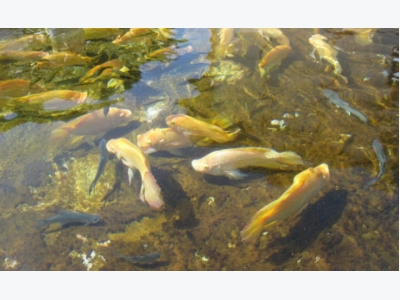5 strategies to get sustainable fish farming right

Aquaculture image by Bytemarks via Flickr
The world's appetite for fish is steadily growing. Finfish and shellfish currently make up one-sixth of the animal protein people consume globally. As the global wild fish catch peaked in the 1990s, aquaculture, or fish farming, has grown rapidly to meet world fish demand, more than doubling production between 2000 and 2012. New research shows that aquaculture production will need to more than double again between now and 2050 to meet the demands of a growing population.
The question is: Can aquaculture grow sustainably?
WRI partnered with WorldFish, the World Bank, INRA, and Kasetsart University to explore this question. Our new paper, Improving Productivity and Environmental Performance of Aquaculture, examines aquaculture's environmental footprint today and explores various scenarios of aquaculture growth to 2050. It uncovers several strategies that can lessen aquaculture's environmental impacts while also ensuring that fish farming provides employment and nutritious food to millions more people.
Aquaculture's impacts: Encouraging trends, but challenges remain
On average, farmed fish convert feed to edible food as efficiently as poultry, making them an attractive option for expanding the global animal protein supply. However, as with all forms of food production, aquaculture isn't without its environmental impacts.
As aquaculture began to boom in the 1990s, several concerns emerged such as the clearing of mangroves to make way for shrimp farms in Asia and Latin America, increased use of fishmeal and fish oil made from wild marine fish, and the generation of water pollution and shrimp and fish diseases. The aquaculture industry greatly has improved performance over the past 20 years, producing more farmed fish per unit of land and water, lowering the share of fishmeal and fish oil in many aquaculture feeds and largely stopping mangrove conversion.

However, doubling aquaculture production without further increasing the industry's efficiency could lead to a doubling of environmental impacts. And unless the aquaculture industry is able to boost productivity, the limited availability of land, water and feed may constrain its growth.
Getting aquaculture growth right: 5 approaches
Our report recommends five approaches to help get aquaculture growth right.
1. Invest in technological innovation and transfer. Aquaculture is a young industry, decades behind that of livestock farming. Improvements in breeding technology, disease control, feeds and nutrition and low-impact production systems are interlinked areas where science can complement traditional knowledge to improve efficiency. These sorts of innovations — whether led by farmers, research institutions, companies or governments — have been behind productivity gains in every part of the world.
For example, in Vietnam, a breakthrough in catfish breeding around 2000, complemented by widespread adoption of high-quality pelleted feed, unlocked a boom in production growth and intensification. Vietnamese catfish production grew from 50,000 tons in 2000 to more than 1 million tons in 2010, even though the country's total catfish pond area only doubled during that time.
2. Focus beyond the farm. Most aquaculture regulations and certification schemes focus at the individual farm level. But having many producers in the same area can lead to cumulative environmental impacts — such as water pollution or fish diseases — even if everyone is following the law.
Spatial planning and zoning can ensure that aquaculture operations stay within the surrounding ecosystem's carrying capacity and also can lessen conflicts over resource use. Norway's zoning laws, for example, ensure that salmon producers are not overly concentrated in one area, reducing disease risk and helping mitigate environmental impacts.
3. Shift incentives to reward sustainability. A variety of public and private policies can give farmers incentives to practice more sustainable aquaculture. For example, Thailand's government has provided shrimp farmers operating legally in aquaculture zones with access to free training, water supply and wastewater treatment. The government has also provided low-interest loans and tax exemptions to small-scale farmers, helping them adopt improved technology that increased productivity, reducing pressure to clear new land.
4. Leverage the latest information technology. Advances in satellite and mapping technology, ecological modeling, open data and connectivity mean that global-level monitoring and planning systems that encourage sustainable aquaculture development now may be possible. A platform integrating these technologies could help governments improve spatial planning and monitoring, help the industry plan for and demonstrate sustainability, and help civil society report success stories and hold industry and government accountable for wrongdoing.
5. Eat fish that are low on the food chain. Fish farming can ease pressure on marine ecosystems if farmed fish don't need large amounts of wild fish in their diets. Consumers should therefore demand species that feed low on the food chain — "low-trophic" species such as tilapia, catfish, carp and bivalve mollusks.
In emerging economies, where consumption of low-trophic species is still dominant, emphasis should continue with these species even as billions of people enter the global middle class in coming decades. At the same time, because fish are a major source of nutrition for more than a billion poor people in the developing world, growing aquaculture to meet the food and nutritional needs of these consumers will be essential.
With the global wild fish catch stagnant and the human population increasing, aquaculture is here to stay. The world, therefore, needs to get its growth right — and ensure that fish farming contributes to a sustainable food future.
Có thể bạn quan tâm
Phần mềm

Phối trộn thức ăn chăn nuôi

Pha dung dịch thủy canh

Định mức cho tôm ăn

Phối trộn phân bón NPK

Xác định tỷ lệ tôm sống

Chuyển đổi đơn vị phân bón

Xác định công suất sục khí

Chuyển đổi đơn vị tôm

Tính diện tích nhà kính

Tính thể tích ao hồ



 Can high-tech bacteria make fish farming more sustainable?
Can high-tech bacteria make fish farming more sustainable?  Will Fish Farming Overtake Cattle Ranching?
Will Fish Farming Overtake Cattle Ranching?